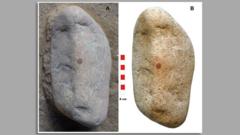Research led by María de Andrés-Herrero from the University of Complutense has uncovered remarkable evidence in the San Lázaro rock shelter, Segovia, where a Neanderthal man is thought to have dipped his finger in red pigment, leaving a fingerprint on a stone carved to depict a nose. This find, believed to date back approximately 43,000 years, has sparked a conversation about the artistic ingenuity of early humans, specifically Neanderthals.
The pebble, discovered after layers of sediment were excavated, drew scientists’ attention due to its unique markings resembling a face. The careful placement of the red dot led the research team to conclude that it represents a form of "symbolic behavior," indicating an ability for abstract thought in Neanderthals, as highlighted by de Andrés-Herrero in a recent interview.
The excavation at this significant site began five years ago, with key discoveries made last year. The research team reached out to Spain's scientific police for an in-depth analysis of the pigment used on the stone. Using multi-spectrum evaluation techniques, they confirmed the presence of a male adult fingerprint, although comparisons with other Neanderthal references remain limited.
This painted object is believed to be the oldest known portable art piece made by Neanderthals in Europe, according to archaeologist David Álvarez Alonso. The research findings present a strong case for the existence of intentional artistic expression, as the pigment cannot be found naturally in the surrounding area—a suggestion that it was purposely brought to the site.
Prof. de Andrés-Herrero emphasized the significance of this discovery, noting it as the first pigment-marked object found in such archaeological contexts and as compelling evidence of Neanderthal symbolic capacity. The team's publication in the journal Archaeological and Anthropological Sciences elucidates the unusual characteristics of the pebble, positioning it as an early example of portable art.
As anthropologists and archaeologists continue to explore the cognitive and creative abilities of Neanderthals, this archaeological gem pushes the boundaries of our understanding regarding the role of art and symbolism in the lives of our ancient relatives.
The pebble, discovered after layers of sediment were excavated, drew scientists’ attention due to its unique markings resembling a face. The careful placement of the red dot led the research team to conclude that it represents a form of "symbolic behavior," indicating an ability for abstract thought in Neanderthals, as highlighted by de Andrés-Herrero in a recent interview.
The excavation at this significant site began five years ago, with key discoveries made last year. The research team reached out to Spain's scientific police for an in-depth analysis of the pigment used on the stone. Using multi-spectrum evaluation techniques, they confirmed the presence of a male adult fingerprint, although comparisons with other Neanderthal references remain limited.
This painted object is believed to be the oldest known portable art piece made by Neanderthals in Europe, according to archaeologist David Álvarez Alonso. The research findings present a strong case for the existence of intentional artistic expression, as the pigment cannot be found naturally in the surrounding area—a suggestion that it was purposely brought to the site.
Prof. de Andrés-Herrero emphasized the significance of this discovery, noting it as the first pigment-marked object found in such archaeological contexts and as compelling evidence of Neanderthal symbolic capacity. The team's publication in the journal Archaeological and Anthropological Sciences elucidates the unusual characteristics of the pebble, positioning it as an early example of portable art.
As anthropologists and archaeologists continue to explore the cognitive and creative abilities of Neanderthals, this archaeological gem pushes the boundaries of our understanding regarding the role of art and symbolism in the lives of our ancient relatives.



















